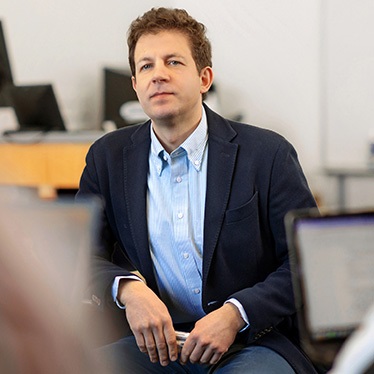
A Conversation With Professor Carol Faulkner About the Declaration of Independence
July 4, 2025
SU News
In June 1776, from a rented room in Philadelphia, Thomas Jefferson penned the first draft of the document that would forge a nation. The stakes were high, amidst the ongoing war with the British, to find the right words to argue the absolute necessity to break from the Crown.
Now, nearly 250 years after its adoption by the Second Continental Congress, the Declaration of Independence remains a stirring treatise that set forth individual rights and rebuked a tyrant king. It still stands as an inspirational—and aspirational—document for the United States and for people around the world.
In anticipation of America’s Semiquincentennial on July 4, 2026, how has the Declaration of Independence stood the test of time?
In this Q&A with SU News, Carol Faulkner, senior associate dean and history professor in the Maxwell School of Citizenship and Public Affairs, shares her insights on the historical themes of the document, our evolving understanding of that period of U.S. history and what she is looking forward to in this anniversary year of commemorations.

Q: In this year leading up to the Semiquincentennial, what do you think are the most significant historical themes we should reflect on?
A: As we approach the 250th anniversary of the United States, I believe both scholars and the public will be focused on the high ideals of the founding—liberty, equality, the pursuit of happiness, democracy, a perfect union—and the nation’s struggle to live up to them.
The most glaring example of this gap between ideals and reality, of course, was slavery, which took the Civil War, and approximately 750,000 deaths, to abolish. American women did not gain full political equality until the 19th Amendment (1920) and the Voting Rights Act (1965). Native Americans gained citizenship in 1924, but they continue to fight to overcome a history of U.S. violence and displacement.
Q: Does the Declaration of Independence and its aspirations still hold up to the test of time? Would Thomas Jefferson and the Continental Congress have been thinking about its longevity?
A: Certainly, the opening of the Declaration of Independence remains inspiring. The rest of the Declaration of Independence lays out their (long!) list of grievances against King George III and Great Britain, and some of these can be quite unclear or puzzling to current readers. It certainly reflected that specific moment in time as Jefferson sought to justify independence.
The Declaration’s impact can be seen in the Seneca Falls Declaration of Sentiments, which set out the goals of women’s rights activists for political, civil and legal equality. And abolitionist Frederick Douglass also took inspiration from the Declaration for his famous speech “What to the Slave is the Fourth of July?” I think these Americans took it beyond what might have been imagined by the founders.
Q: How has our national understanding of the American Revolution evolved over time, and what new perspectives/research are historians bringing to light?
A: Historians now view the American Revolution as part of a broader age of revolutions (for example, the Haitian and French revolutions) with its impact reverberating throughout the western hemisphere and Atlantic world. University historian Tessa Murphy’s prizewinning book “ Creole Archipelago,” which examines British and French imperial goals in the Caribbean, is one example of this new scholarship.
In addition, historians have also focused more on the impact of the American Revolution on Native American Indians. Alumnus Michael Oberg G’94, a professor of history at SUNY Geneseo, for example, has written an important book on the 1794 Treaty of Canandaigua between the Haudenosaunee and the U.S. called “ Peacemakers.”
Q: What are some lesser-known or overlooked events or figures from the founding period that deserve more attention during the Semiquincentennial?
A: There are so many interesting people from this period! Elizabeth “Mumbet” Freeman was an enslaved woman who sued for her freedom and helped end slavery in Massachusetts in 1783. And, while most Americans know who Betsy Ross is, her life as a Quaker and skilled seamstress is fascinating beyond the fact that she sewed the flag.
Closer to central New York, Joseph Brant and his sister Molly, leading members of the Mohawk nation, were allied with the British. The Marquis de Lafayette, after whom so much is named in this area, was an important ally and military leader for the American Revolutionaries and became an influential figure in the broader age of revolutions into the 19th century.
Q: As a historian, what are you looking forward to as we revisit the founding of the United States and celebrate the nation’s 250th anniversary?
A: I was 7 years old in 1976, so I don’t have many memories of the bicentennial, but I will be interested to see what celebrations occur, and how these celebrations might be contested.
While anyone would be hard pressed to say the U.S. has achieved true equality, freedom or democracy, the country has made significant, if incomplete, efforts. I’d like to see events and festivities that reckon with this complicated history.
I’m also looking forward to a class that Maxwell colleagues and I will be teaching in spring 2026 on the “USA @ 250,” which will focus on key issues in U.S. history, society and politics from the Revolution to the present.
By Kathleen Haley
For any media who wish to schedule an interview with Faulkner, please reach out to Vanessa Marquette, media relations specialist, at vrmarque@syr.edu.
Faulkner was also featured in the Spectrum News article, “N.Y. professor looks at the further impacts of the Declaration of Independence,” and was a guest on the Dave Allen podcast for the segment, “What Does the Declaration of Independence Teach Us Today?”
Related News
Research

Jul 16, 2025
Research

Jul 16, 2025
School News

Jul 16, 2025
